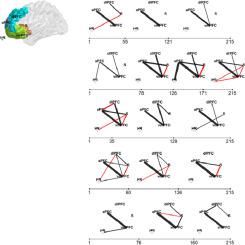Medical Image Analysis ( IF 10.7 ) Pub Date : 2021-09-30 , DOI: 10.1016/j.media.2021.102252 Andreas Anastasiou 1 , Ivor Cribben 2 , Piotr Fryzlewicz 3

|
Evidence of the non stationary behavior of functional connectivity (FC) networks has been observed in task based functional magnetic resonance imaging (fMRI) experiments and even prominently in resting state fMRI data. This has led to the development of several new statistical methods for estimating this time-varying connectivity, with the majority of the methods utilizing a sliding window approach. While computationally feasible, the sliding window approach has several limitations. In this paper, we circumvent the sliding window, by introducing a statistical method that finds change-points in FC networks where the number and location of change-points are unknown a priori. The new method, called cross-covariance isolate detect (CCID), detects multiple change-points in the second-order (cross-covariance or network) structure of multivariate, possibly high-dimensional time series. CCID allows for change-point detection in the presence of frequent changes of possibly small magnitudes, can assign change-points to one or multiple brain regions, and is computationally fast. In addition, CCID is particularly suited to task based data, where the subject alternates between task and rest, as it firstly attempts isolation of each of the change-points within subintervals, and secondly their detection therein. Furthermore, we also propose a new information criterion for CCID to identify the change-points. We apply CCID to several simulated data sets and to task based and resting state fMRI data and compare it to recent change-point methods. CCID may also be applicable to electroencephalography (EEG), magentoencephalography (MEG) and electrocorticography (ECoG) data. Similar to other biological networks, understanding the complex network organization and functional dynamics of the brain can lead to profound clinical implications. Finally, the R package ccid implementing the method from the paper is available from CRAN.
中文翻译:

交叉协方差隔离检测:一种估计动态功能连通性的新变化点方法
在基于任务的功能磁共振成像 (fMRI) 实验中甚至在静息状态 fMRI 数据中观察到了功能连接 (FC) 网络的非平稳行为的证据。这导致开发了几种新的统计方法来估计这种随时间变化的连通性,其中大多数方法使用滑动窗口方法。虽然计算上可行,但滑动窗口方法有几个限制。在本文中,我们通过引入一种统计方法来绕过滑动窗口,该方法可以在 FC 网络中发现变化点的数量和位置是先验未知的。新方法,称为交叉协方差隔离检测(CCID),检测多变量、可能是高维时间序列的二阶(交叉协方差或网络)结构中的多个变化点。CCID 允许在存在可能小幅度的频繁变化的情况下检测变化点,可以将变化点分配给一个或多个大脑区域,并且计算速度很快。此外,CCID 特别适用于基于任务的数据,其中受试者在任务和休息之间交替,因为它首先尝试隔离子区间内的每个变化点,然后在其中检测它们。此外,我们还为 CCID 提出了一个新的信息标准来识别变化点。我们将 CCID 应用于几个模拟数据集以及基于任务和静息状态的 fMRI 数据,并将其与最近的变化点方法进行比较。CCID 还可适用于脑电图 (EEG)、红脑图 (MEG) 和皮层电图 (ECoG) 数据。与其他生物网络类似,了解大脑的复杂网络组织和功能动态可以产生深远的临床意义。最后,R包ccid实现了论文中的方法可从 CRAN 获得。











































 京公网安备 11010802027423号
京公网安备 11010802027423号